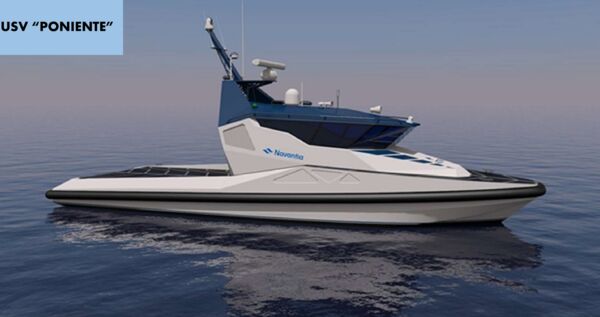
Poniente will be Navantia's test platform for future development of capabilities in the field of unmanned vehicles. (Navantia)
Navantia is scheduled to start the construction of a new multimission modular unmanned surface vehicle (USV) in early 2023.
The shipbuilder is finalising the detailed design of the platform and embarked systems, its programme director for Europe, Angelina Cajade Frías, told Janes.
The USV, called Poniente, is part of the company's Viento family of multimission USVs. It is being developed as a self-funded research and development project to validate the latest technologies in the field of autonomous navigation, as well as serving as a test and demonstration platform for intelligence, surveillance, and reconnaissance (ISR), mine warfare, anti-submarine warfare (ASW), and oceanographic and hydrographic survey missions.
The USV will be based on a 10 m-long aluminium monohull boat from Spanish shipyard AISTER, and will be equipped with cameras, a navigation radar, an electro-optical sensor, a light detection and ranging (LIDAR) radar, an automatic identification system (AIS), a sonar system, a Global Positioning System (GPS) receiver, and an inertial navigation system (INS).
The propulsion will consist of two inboard engines.
Poniente will be capable of deploying effectors such as unmanned underwater vehicles (UUVs), remotely operated vehicles (ROVs), unmanned aerial vehicles (UAVs), and sonobuoys.
Harbour and sea trials are scheduled to be conducted at Navantia's San Fernando shipyard starting in mid-2023. The USV will also be equipped with the company's Naval Advanced Integrated Autonomous vehicles Defence (NAIAD) command-and-control system to enable integration with the Navantia Sistema de COMbate de los Buques de la Armada (SCOMBA) combat management system (CMS).
Integration tests between the USV and the SCOMBA CMS will be conducted at Navantia's land-based test site in San Fernando, Cajade said.
Looking to read the full article?
Gain unlimited access to Janes news and more...







